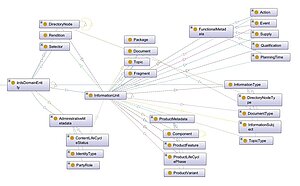The intelligent information Request and Delivery Standard (iiRDS) is a technical standard for the delivery of digital information for use or technical documentation such as electronic operating instructions and user manuals. iiRDS can be used free of charge and is published under a Creative Commons license.
A group of experts at tekom started to develop iiRDS in 2016. In 2018, the iiRDS Consortium was established to maintain and further develop the standard. In 2025, the Consortium is focusing on raising awareness of iiRDS at events while also advancing international standardization efforts.
Benefits of iiRDS
iiRDS enables the manufacturer-independent delivery, exchange, and aggregation of information for use. This is particularly relevant in the context of Industry 4.0 and the Industrial Internet of Things (IIoT), where technical information from different manufacturers in plants and smart factories is combined.
iiRDS focuses solely on standardizing the exchange format and is not concerned with the way content is created and maintained. This focus on the delivery format for smart content enables iiRDS users to author the content using different programs, for example, content management systems.
The standard consists of a format that defines the file and folder structure of the package containing intelligent information as well as an ontology for enriching content with metadata.
Content enriched with iiRDS metadata supports functions for searching and filtering information and other content functionalities. This smart content can thus be found faster and more accurately in self-service portals, documentation portals, or apps.
A use case
Take the classic iiRDS use case of a service technician tasked with the maintenance or troubleshooting of a product: Here, iiRDS enables the display of the necessary information for the affected machine part that needs to be replaced and shows the relevant information – either directly on the product or via an associated app. The service technician doesn’t have to browse through manuals or PDF documents. Even if the service technician is used to classic information for use, he would have to either search in the PDF manually or the search results would depend on the exact term he has entered into the search bar.
Metadata is key for intelligent information. iiRDS provides the appropriate tools for modeling such use cases, thus offering the option to present information for use in an individual, user-oriented, and context-related way. This is especially beneficial for manufacturers of more complex products that integrate various components and the respective information from external suppliers, who use differing terminology. iiRDS standardizes metadata and provides a packaging format for archiving and exchanging technical communication.
Check out our best practice examples of iiRDS implementations.
Metadata model
iiRDS uses the Resource Description Framework Schema (RDFS) as the technical format for its metadata model. After registration, these RDF files can be downloaded from the iiRDS Consortium website for free.
| RDF Schema (RDFS) provides a data-modeling vocabulary for RDF data. RDFS is an extension of the basic RDF vocabulary and belongs to the family of semantic web standards maintained by the World Wide Web Consortium (W3C). A common vocabulary – or ontology – is needed to interpret statements formulated in RDF. RDF is not a metadata vocabulary, but a data model for statements about resources. It can be used to develop vocabularies such as iiRDS, which contains a vocabulary for technical communication. There are also other ontology description languages such as Web Ontology Language (OWL). For further information, visit the W3C website. |
iiRDS metadata can be assigned to text fragments, topics, or documents. The iiRDS metadata model is based on the PI classification by Prof. Dr. Wolfgang Ziegler (I4ICM) and defines the categories of metadata shown in Figure 1.

Figure 1: Excerpt of the iiRDS metadata in the Protégé tool
The metadata model can be extended by adding new subclasses or objects to existing iiRDS classes. iiRDS explicitly supports the extension of the metadata model and provides what are called “docking points” for linking external metadata, for example, product metadata or role and qualification definitions.
Delivery format
The iiRDS package is a ZIP file containing the content to be delivered and the associated metadata as RDF. iiRDS comes in two variants regarding the format of content:
- Unrestricted packages can contain any kind of format, for example, PDF, HTML, XML, MP4, SVG, or Office files.
- Restricted packages in the iiRDS/A format contain content only in predefined formats and are self-contained. The predefined formats are PDF/A, a restricted selection of media formats, and XHTML5 with element and attribute restrictions. iiRDS packages are self-contained when the content files only point to files within these packages. The restrictions of the iiRDS/A format aim to ensure that all iiRDS-capable applications process and present the content in similar ways without any additional implementation or customization effort.
- A new format, iiRDS/H, will be included in the next iiRDS version to be released in Q2 2025. This self-contained format is still under development but covers some new developments, e.g. an optional JSON-LD serialization, thus coming closer to the Request API, offering more direct support for chatbots and a lot more new features.
Free iiRDS tools to get you started
iiRDS defines a standardized format for delivering smart content from an application that creates iiRDS packages from content (e.g. CMS, authoring or converter tools, iiRDS Open Toolkit) to an application that receives and processes iiRDS packages (e.g. content delivery portals or self-service portals).
To support the application, the iiRDS Consortium provides an Open Toolkit that can be used to enrich content with metadata. Users can upload the content in common formats such as PDF, Word, HTML and XML files. It then generates a valid iiRDS package from content and metadata that the user can check, revise, or add custom metadata values to. The iiRDS Consortium also provides an iiRDS Validation Tool to validate iiRDS packages from other systems.
The iiRDS Request API specification enables access to data via iiRDS, thus meeting the growing requirements of the economy. It offers system providers and programmers a standardized interface, ensuring modern functionality to support seamless integration. It also offers extended capabilities by covering a broad range of use cases and allows developers to choose the most suitable query method for their specific needs.
In November 2024, the iiRDS Consortium released the iiRDS Request API mockup. This tool is designed to help developers get hands-on experience with the iiRDS Request API, offering an entry point for implementing the full iiRDS specification.
Key features of the iiRDS Request API Mockup include:
- Comprehensive Route Coverage: Includes all routes defined by the iiRDS Request API specification.
- Sample Responses: Generates responses that are syntactically correct per the iiRDS Request API specification, based on static sample data. While the mockup doesn’t provide dynamic or parameter-sensitive responses, it does validate the syntax and structure of API call parameters.
- Built for Flexibility: Implemented as a Node.js project, the mockup is easy to run in any environment with Node.js installed. A Dockerfile is also included, allowing you to run the mockup in a containerized environment effortlessly.
The API mockup leverages the OpenAPI 3 definition of the iiRDS Request API to generate its structure and integrates with the Node.js Express library. It operates as a standalone web server, making it a breeze to test and experiment with. Whether you're looking to prototype integrations or explore the iiRDS Request API, this mockup provides a robust starting point for your development journey.
These tools are available as a free web service on the iiRDS website.
The iiRDS Plugin for DITA-OT, released in March 2024, is discussed in more detail here.
Standardization and interoperability
The iiRDS Consortium has contributed significantly to developing the "Intelligent Information for Use" submodel of the Asset Administration Shell (AAS), published by the Industrial Digital Twin Association (IDTA). IDTA submodels are designed for standardization by the IEC, supporting automated communication between assets, and serve as the foundation for interoperability in digital twins of industrial systems. This submodel provides a standardized link between assets and software systems, addressing the challenges posed by traditional document-based formats like PDFs, which often lack adequate metadata. Based on the iiRDS standard, the submodel aims to bridge information gaps with a metadata model for intelligent information, enabling efficient, cross-manufacturer exchange and aggregation of technical data.
The iiRDS Consortium is collaborating with the Digital Data Chain Consortium (DDCC) on a joint standardization effort to establish iiRDS and digital manufacturer information as international standards. As a result, a New Work Item Proposal (NP) is now undergoing a vote in IEC Technical Committee 3. The voting results are expected in March 2025. This NP, based on IEC PAS 63485, incorporates iiRDS content, digital manufacturer information, and references to the digital product passport and relevant IDTA submodels like "Handover Documentation" and "Intelligent Information for Use." If approved, IEC TC 3 Working Group 28 will work on the draft, further boosting iiRDS's relevance and impact as it becomes anchored in international standardization.
Getting involved
Here is how you can participate in iiRDS developments:
- Register on our website, iirds.org, and subscribe to our newsletter to receive relevant updates on new releases, events, webinars, training sessions and more.
- Upon registration, you can access the iiRDS materials such as the current iiRDS version, the sample content, and the iiRDS Whitepaper to get started.
- Start an iiRDS pilot project accompanied by a Consortium member in the consultants pool. Insights into previous pilot projects can be found on our website under Best Practices. Funding is announced annually. The application phase opens in spring.
- Take part in our iiRDS Online Training to gain a solid foundation of theoretical and practical knowledge about iiRDS in six weeks of self-study supplemented by group work, online meetings and quizzes. The next training will take place from April 28 to June 18, 2025.
- Become a Consortium member. Discuss your experience with iiRDS experts and get first-hand insights into various projects on intelligent information. In the Consortium, you get the chance to be part of the development of the standard. Join our working groups (Development, Content-Tools-Validation, Standards) or the consultants pool and take part in the training at a discounted rate.

